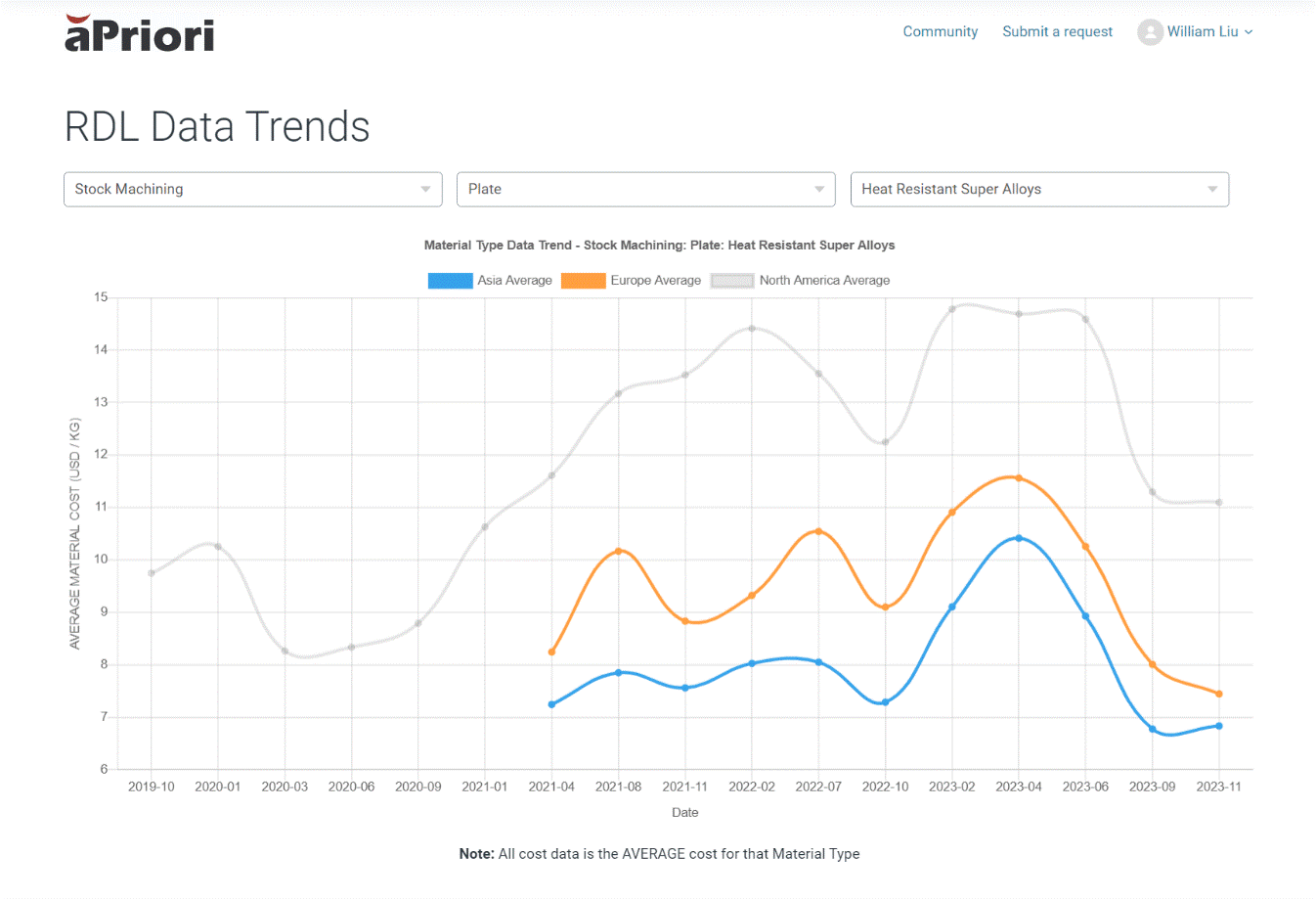Key Takeaways:
- Get our latest global manufacturing cost data to see if you’re overpaying for materials and factory labor
- We provide quarterly updates across nearly 90 regions
The Full Article:
Inflation, regional unrest, natural disasters, and economic policy changes can cause big swings in material, labor, and other manufacturing costs. To help ensure that manufacturers pay accurate “should costs” amid dynamic economic shifts, aPriori provides detailed manufacturing cost information in nearly 90 regions for real-time analysis and decision-making.
We update our Regional Data Libraries (RDLs) quarterly, and this is our inaugural blog to share select pricing and rate information from our latest RDL release. The Spring 2024 RDL release blog includes select trending information from our latest RDL release along with outlook insights.
The quarterly RDL blogs will also highlight new features and manufacturing areas added to expand the scope of our cost and sustainability insights. This Spring 2024 RDL release blog includes select trending and outlook:
- Labor rate highlights and outlook
- Exchange rate highlights
- Material rate highlights
- New material price history feature
- New manufacturing cost and sustainability data
Find out what’s included in our RDLs by downloading our data sheet.
 1. Labor Rate Highlights and Outlook
1. Labor Rate Highlights and Outlook
aPriori tracks fully burdened labor rates across nearly 90 regions worldwide. Below we’ve provided select labor rate changes compared to the previous quarter’s RDL for four countries and 11 sub-regions.
Brazil:
- Quarterly change: A nine-year low in the country’s unemployment rate fueled double-digit wage increases this past quarter.
- Outlook: Brazil’s discrete manufacturing sector continues to grow, which could continue to push wages higher in some manufacturing segments. Although overall industrial production declined 1.6% in January 2024, the Brazilian government reports an increase in discrete manufacturing sectors including:
- computer equipment, electronic and optical products (13.7%)
- automotive vehicles (4%)
- machinery and equipment (6.4%)
Overall, Brazil’s manufacturing sector growth is projected to be 3.54% CAGR 2024–2028 (compound annual growth rate), according to Statista.
India:
- Quarterly change: aPriori’s independent research determined that base wages were too low – and did not accurately reflect the wage pressure caused by the country’s high growth. We increased the RDL labor rates for India (country-wide average) and its four sub-regions.
- Outlook: Expect India’s growth to continue (it expanded 8% during the last fiscal year, which ended March 31). The economic boom and associated inflation may continue to push wages higher. Deloitte notes that global manufacturers continue to turn to India for supply chain resilience amid international tensions. Internally, pundits don’t expect the national elections to affect manufacturing wages or the economy in the short term.
Mexico:
- Quarterly change: Wages also increased markedly across Mexico’s three sub-regions due to a boost in base wages and direct benefits. This is likely an ongoing ripple effect from “reshoring/nearshoring” initiatives spurred by the pandemic and the United States-Mexico-Canada Agreement designed to streamline trade in North America.
- Outlook: June’s national election makes the outlook uncertain, according to the Baker Institute. Uneven economic data so far this year supports projections that Mexico’s GDP will grow between 2%-3% this year, a drop from 2.5%-3.5% this past year.
Poland:
- Quarterly change: Manufacturing wages dipped around 5% during the past quarter primarily due to Russia’s ongoing war in Ukraine, according to the International Trade Administration.
- Outlook: Although consumer spending is projected to drive Poland’s 3% GDP growth this year, economic uncertainty and associated trade disruptions could curtail these projections and keep manufacturing wages stagnant.
2. Exchange Rate Highlights
Global exchange rates have remained relatively steady since aPriori’s last quarterly release, with a couple of notable exceptions:
Russia: In the wake of the Ukraine war’s economic impact, Russia has forced exporters to convert their foreign revenues into Rubles to prop up its currency. This action resulted in a nearly 14% increase in the Ruble’s value compared to the US dollar. More broadly, the International Monetary Fund (IMF) expects war-related sanctions to blunt Russia’s economic growth.
Turkey: Turkey continues to pull economic levers to address inflation, which reached 68.5% in March, according to new government data. Inflation woes and other factors have been decreasing the Lira’s value against the US dollar benchmark. Turkey President Erdogan has pledged to continue the country’s aggressive rate hikes to tame inflation despite losses his party suffered during recent regional elections.
3. Material Rate Highlights
Although many material prices remained stable, the following changes are noteworthy since last quarter:
Non-Ferrous Metals
- During the last quarter of 2023, iron ore production decreased while demand grew for iron ore and coking coal (metallurgical coal). These trends resulted in ~10% price increases for Gray iron, Ductile iron, and Malleable Cast Iron.
- Increased production and decreased demand from downstream industries led to reduced prices for Inconel, Hastelloy, and other heat-resistant super alloys between 10-15%.
Plastics
- High density polyethylene (HDPE) price increases at the end of 2023 were primarily caused by lower production rates at regional plants and limited imports from foreign suppliers. Steady demand from the downstream packaging sector also supported these price gains.
- Increased demand, rising monomer costs, and precautionary buying in the wake of the Middle East conflict contributed to double-digit price increases for Polypropylene (PP) thermoplastic and Polyethylene.
Please note that aPriori further refines material pricing across three regions to address geographical factors: Asia, Europe, and World Averages (North and South America, Africa, and Australia).
4. New Material Price History Feature
aPirori has introduced a new material price history feature that provides comprehensive historical cost data for industrial raw materials. The new RDL Data Trends feature enables users to review material price history quickly to assess market trends and help refine their procurement strategies. Key features include:
- Trend the average cost per kg of each material type
- View the historical average costs of a material type by hovering over a material date
- View material costs in three regions: Asia, Europe, and North America
- Compare three material stock forms simultaneously for cost
- Export or print the graph to share in reports or with stakeholders
 RDL Data Trends charts the average cost per kg of each material type. aPriori provides material costing information for plastic molding, sheet metal, and stock machining process groups. Watch for updates.
RDL Data Trends charts the average cost per kg of each material type. aPriori provides material costing information for plastic molding, sheet metal, and stock machining process groups. Watch for updates.
5. New Manufacturing Cost and Sustainability Data
Sustainability Updates
aPriori incorporates sustainability data from ecoinvent, a leading global database for life cycle inventory (LCI) information, into its Manufacturing Insights Platform. Updates from ecoinvent include:
- Electricity Emissions Factors: aPriori is using the most recent carbon emissions factors (electricity market mix) via ecoinvent’s latest update.
- Material Emissions Factors: econivnet and PlasticsEurope collaborated to refine carbon emissions factors for a variety of plastic materials. Additionally, aPriori expanded its plastics coverage to include acrylic (PMMA) via ecoinvent.
- Surface Treatment Emissions Factors: Updates to CO2e emissions span powered coating and plating manufacturing processes for materials ranging from aluminum to zinc.
- Consumable Emission Factors: Calculations for carbon emissions factors continue to gain precision and accuracy as they adopt relevant, real-world datasets. The latest RDL release updates the current material emissions factor based on material and specific manufacturing processes.
Overhead Updates
aPriori determines a direct and indirect overhead hourly rate for individual manufacturing machines across nearly 90 regions.
We add new machines to each RDL release to provide customers with added granularity to estimate the cost and duration of specific manufacturing processes. The Spring 2024 RDL includes new machine data for:
- PCP dip-tank process enhancements
- A laser drilling process for the PCB fabrication manufacturing process model
Get a deep dive into formulas used to calculate total manufacturing costs by region.
Preview of the Fall 2024 RDL Blog
Manufacturers use our RDL data throughout the product development life cycle – from developing early budget estimates and conducting fact-based negotiations – to estimating the cost and CO2e impact of design alternatives for value engineering projects. Our Fall 2024 RDL blog will include:
- Total manufacturing rates in select geographies (trending information and forecast)
- Labor rate information from countries and regions with the highest fluctuations during the past quarter
- Material rate trending information
Get our Cost Estimation Guide
Read how to eliminate gaps in your cost estimation process







